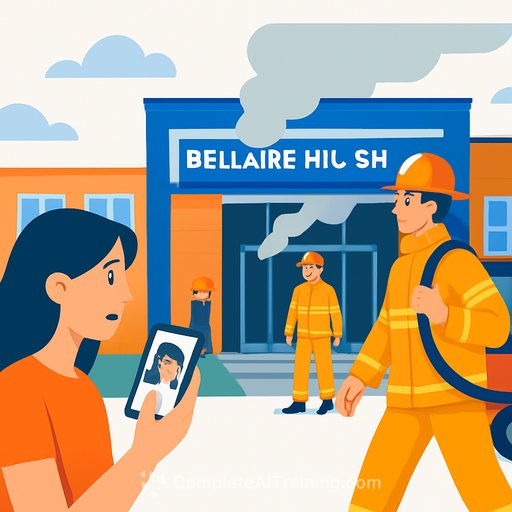AI-Generated Photo Blamed for Fire Hoax at Bellaire High School: What Educators Can Do Next
On Monday morning, Nov. 10, 2025, Bellaire Fire Department crews responded to a reported fire at Bellaire High School. From the outside, there was no visible smoke or flames. Inside, firefighters found a small amount of smoke near a locker area tied to the school's HVAC system.
Houston ISD said the building's alarm triggered before the start of classes due to a freon leak. Students and staff inside were evacuated while others remained outside until the all-clear. Everyone was later allowed back in.
City officials said a fake, AI-generated image circulating on social media-allegedly showing the campus on fire-fueled the panic. Police said there is no open investigation and deferred to the district. The alleged photo could not be independently verified.
Key takeaways for school leaders
Emergencies now have two fronts: the incident itself and the rumor mill that forms around it. Your response plan needs both. The goal is simple-confirm facts fast, communicate through trusted channels, and keep students, staff, and families focused on safety.
Immediate actions to tighten your campus response
- Establish a single source of truth. Lock in official channels (district website banner, SMS, school app, robocall, and principal/PIO social accounts) and publish them in handbooks and welcome packets.
- Set a rapid verification workflow. Designate who confirms photos/videos (principal, PIO, safety lead) before anyone re-shares them. Require a quick cross-check with facilities and first responders.
- Use simple tools. Run suspect images through a reverse image search and compare with known campus photos. Log what you checked and when.
- Publish holding statements within minutes. Example: "We're investigating an alarm at [School]. Please avoid speculation. Updates will be posted here every 10 minutes."
- Assign social listening during arrival/dismissal. One staff member monitors major platforms and routes rumors to the PIO for a yes/no response.
- Coordinate with fire and police PIOs. Pre-write message templates they can co-sign and cross-post.
- Run drills that include misinformation. Add a "fake photo scenario" to your next tabletop: who verifies, who posts, what gets sent to parents, and how fast.
- Update HVAC/alarm SOPs. Note causes like freon leaks, inspection steps, and the exact language you'll use to explain them to families.
- Give parents a clear rumor-reporting path. A simple form or phone line beats dozens of DMs. Ask families not to re-share unverified posts.
Quick checklist for verifying crisis photos
- Look for tells: warped text, inconsistent shadows, odd reflections, mismatched signage, or impossible angles.
- Time and place: does the lighting and weather match right now? Compare with live cams or recent campus photos.
- Run a reverse image search and check for reused backgrounds or prior versions.
- Favor media with provenance. Some images carry Content Credentials that show edits and source details. Learn how they work here: Content Credentials.
- Share basic media-literacy guidance with your community using non-technical language. CISA's resources are a good starting point: CISA on Mis-, Dis-, and Malinformation.
How to communicate the all-clear
When it's safe to re-enter, say what happened, what was checked, and what's next. Example: "Alarm sounded due to a freon leak in the HVAC system. Fire crews inspected and cleared the building. Classes have resumed. Facilities will complete repairs after school. No injuries." Consistency across email, text, website, and social keeps rumors from filling the gaps.
Build staff and student AI literacy
Teach your team to pause, verify, and route suspicious content through the right channel. A short in-service can cover image red flags, who to call, and what to post. If you're building capacity, consider practical AI-literacy and comms training for school roles: AI courses by job.
Bottom line: incidents like this are manageable with a tight verification process, pre-written messages, and clear channels. Set the plan now so your next alert is calm, fast, and accurate.
Your membership also unlocks:






